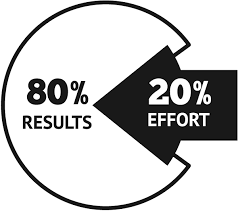Anthony Donskov
The Pareto Principle: Strength and Conditioning Implications
- Font size: Larger Smaller
- Hits: 4108
- Subscribe to this entry
- Bookmark
Vilfredo Pareto (1848-1923), an Italian polymath/economist was credited with the “Principle of Unequal Distribution.” Management consultant Joseph Juran suggested the principle and named it after Pareto, who at the time showed that approximately 80% of the land in Italy was owned by 20% of the population. The Principle of Unequal Distribution has been used to describe:
- Finance: The top 1% of earners make as much as the bottom 50%
- Science: The majority of scientific papers are produced by a very small group of scientists
- Music: A handful of musicians are responsible for the plethora of record sales. Bach, Beethoven, Mozart, and Tchaikovsky have written almost all the music played by modern orchestras
- Book Sales: A handful of authors sell all the books (a million and a half separately titled books sell each year in the US. However, only 500 of these sell more than 100,000 copies (https://www.sciencedirect.com/science/article/pii/S0378437110001482)
- Language: 90% of communication occurs using just 500 words

The Principle of Unequal Distribution, also known as Price’s Law (after Derek J. de Solla Price), and the Matthew Principle (after Matthew 25:29 in the bible) has also been used in the strength community to design programs. At Donskov Strength and Conditioning, fellow athletes/clients may notice a few consistent trends throughout their programming that pertain directly to the Pareto Principle. In particular, the use of a small number of foundational lifts. Here’s the Principle in action:
The Pareto Principle of Exercise Selection
- 80% of your results, will come from 20% of your exercises: Large, multi-joint lifts are programming staples. Why:
- Tax the entire system: From a global standpoint these lifts aid in recruiting more muscle, increasing systemic force production and maximizing time
- For weight loss clients: this equates to > work, > work equates to > calories
- For athletes: large, multi-joint patterns are conducive to recruiting more muscle mass, > motor unit recruitment due to the fact that they can be maximally loaded while resisting gravity. In addition, these patterns are thought to be more directly transferable to field/ice-based sports
If your program is built on a solid foundation of a small number of foundational lifts such as: squats, deadlifts, pressing and pushing, coupled with auxiliary exercises (yes, isolation exercises are ok) that compliment these pillars, chances are Vilfredo Pareto is alive and well in your gym.
